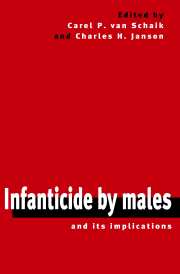Book contents
- Frontmatter
- Contents
- List of Contributors
- Foreword
- Infanticide by males: prospectus
- Part I Introduction
- Part II Infanticide by males: case studies
- 4 Infanticide in red howlers: female group size, male membership, and a possible link to folivory
- 5 Infanticide in hanuman langurs: social organization, male migration, and weaning age
- 6 Male infanticide and defense of infants in chacma baboons
- 7 Infanticide by males and female choice in wild Thomas's langurs
- 8 The evolution of infanticide in rodents: a comparative analysis
- 9 Infanticide by male birds
- Part III Behavioral consequences of infanticide by males
- Part IV Infanticide by females
- Part V Conclusion
- References
- Species index
- Subject index
7 - Infanticide by males and female choice in wild Thomas's langurs
Published online by Cambridge University Press: 04 November 2009
- Frontmatter
- Contents
- List of Contributors
- Foreword
- Infanticide by males: prospectus
- Part I Introduction
- Part II Infanticide by males: case studies
- 4 Infanticide in red howlers: female group size, male membership, and a possible link to folivory
- 5 Infanticide in hanuman langurs: social organization, male migration, and weaning age
- 6 Male infanticide and defense of infants in chacma baboons
- 7 Infanticide by males and female choice in wild Thomas's langurs
- 8 The evolution of infanticide in rodents: a comparative analysis
- 9 Infanticide by male birds
- Part III Behavioral consequences of infanticide by males
- Part IV Infanticide by females
- Part V Conclusion
- References
- Species index
- Subject index
Summary
Introduction
It is now widely accepted that infanticide by males has affected important features of primate social organization by selecting for various social counterstrategies of females (Hrdy 1979; Smuts & Smuts 1993; van Schaik 1996; Treves & Chapman 1996; see various chapters in this book). One of these possible female counterstrategies is female secondary transfer (Marsh 1979b; Sterck 1997; Sterck & Korstjens, Chapter 13). Female transfer decisions are expected to be strongly influenced by the identity of the male with whom a female associates. Secondary transfer is expected only where female relationships are relatively weak because it means the break-up of associations and coalitions, at least temporarily. Hence, given the predominance of female philopatry in primates, only a small number of species is expected to show this behavior. Thomas's langurs (Presbytis thomasi) are one of the few species known to show female secondary transfer related to infanticide avoidance. Females leave when infants have died or when they are old and independent enough to be left behind (Sterck 1997; Steenbeek 1999a). This makes the Thomas's langur an excellent choice for investigating the possible influence of infanticide on social relationships, since in species like this female choice in relation to male characteristics and strategies will be most manifest.
Species with regular female secondary transfer are of particular interest, because where the group contains only a single male, female emigration may terminate a group's lifespan.
- Type
- Chapter
- Information
- Infanticide by Males and its Implications , pp. 153 - 177Publisher: Cambridge University PressPrint publication year: 2000
- 29
- Cited by

